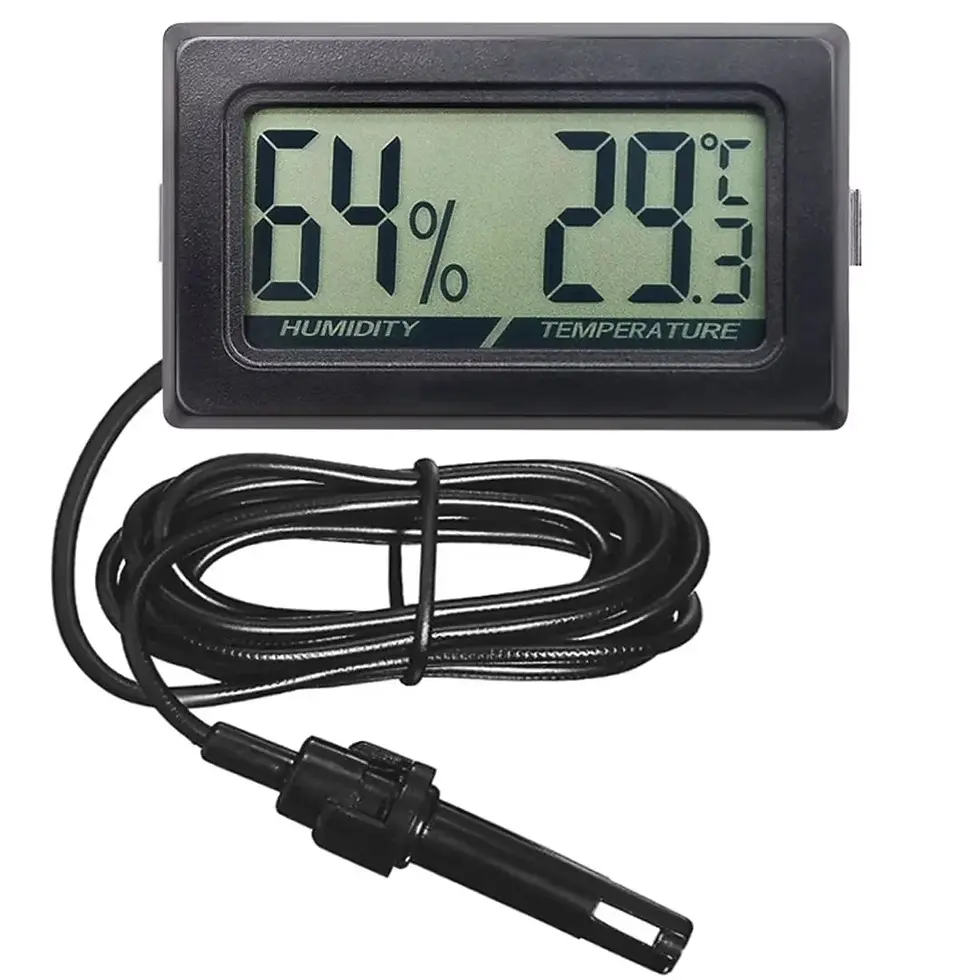
Thermometers & Hygrometers
- thehappyhermie

- Jul 14
- 3 min read
It is essential to have a dependable thermometer and hygrometer in your tank.
These instruments are crucial for monitoring the temperature and humidity levels, ensuring they remain within the appropriate parameters.
Thermometers
A wide variety of thermometers are available on the market, ranging from analog to digital models. Options include compact designs that are positioned outside the tank with a cord extending inside, as well as more sophisticated choices like Bluetooth thermometers, which connect to your phone for remote monitoring and are fully submerged within the tank.
It is strongly advised to use a digital thermometer, as these devices offer significantly greater accuracy compared to analog thermometers.
Hygrometer
Hygrometers are instruments used to measure the moisture content in the air, commonly referred to as humidity. Since hermit crabs require high humidity levels to breathe effectively through their modified gills, it is essential to regularly monitor these humidity levels.
Land hermit crabs possess modified gills that enable them to extract oxygen from environments with high humidity levels, which is essential for their respiration. Additionally, maintaining high humidity is crucial for keeping their gills moist. Low humidity can lead to the drying of the gills, resulting in irreversible damage that may gradually cause suffocation.
Analog hygrometers are available, but they tend to be highly inaccurate. Therefore, we recommend using digital models for more reliable measurements.
Purchasing a combined thermometer and hygrometer unit is significantly more cost-effective and space-efficient. Although these instruments are frequently sold separately, there are models available that measure both temperature and humidity in a single device.
Optimal Placement of Your Reader
For the most precise readings, position your reader at the centre of the tank, approximately 2-3 cm above the substrate. Consider using a rock, piece of wood, or decorative item to support the device, ensuring it does not rest directly on the substrate. If the reader is positioned too close to the heat source, pools, or directly on the substrate, the readings obtained will be inaccurate and will not accurately reflect the actual temperature and humidity levels of your tank.
Although most devices are pre-calibrated, it is advisable to verify the calibration of your hygrometer personally.
Steps to Calibrate Your Hygrometer:
Step 1 - Gather a zip lock bag, kitchen salt, and a small container, such as a bottle cap or medicine cup.
Step 2 - Fill the selected small container with kitchen salt and add a few drops of water until the salt is moist but not saturated.
Step 3 - Place the moist salt container inside the zip lock bag along with your hygrometer device and seal the bag.
Step 4 - Position the bag on a level surface, such as a countertop or kitchen table, and leave it undisturbed overnight.
Step 5 - Before opening the bag, check the humidity level displayed on the hygrometer. It should read 75%. If it does, your hygrometer is accurate, and no further action is required. If the reading is above or below 75%, you will need to calculate the difference to obtain the correct reading.
Example:
For a reading of 80%, it is necessary to subtract 5% when using your hygrometer inside the tank.
For a reading of 70%, you should add 5% when using your hygrometer inside the tank.
If you have a Bluetooth model, you can usually adjust the reading and calibrate it using the phone app. Prior to removing your hygrometer from the bag, open the app and set the humidity reading to 75%. Your hygrometer will then provide an accurate reading.









Comments